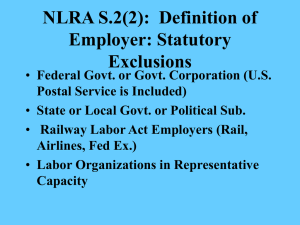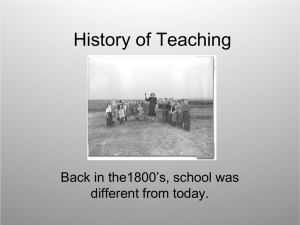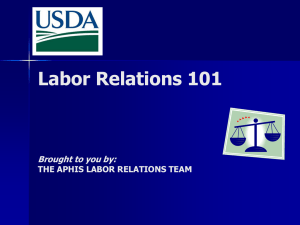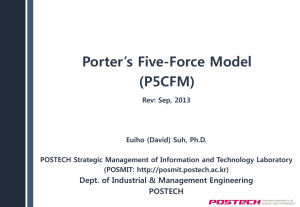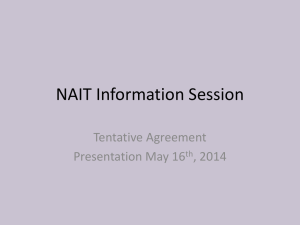(Bargaining Processes) Bill 2014
advertisement
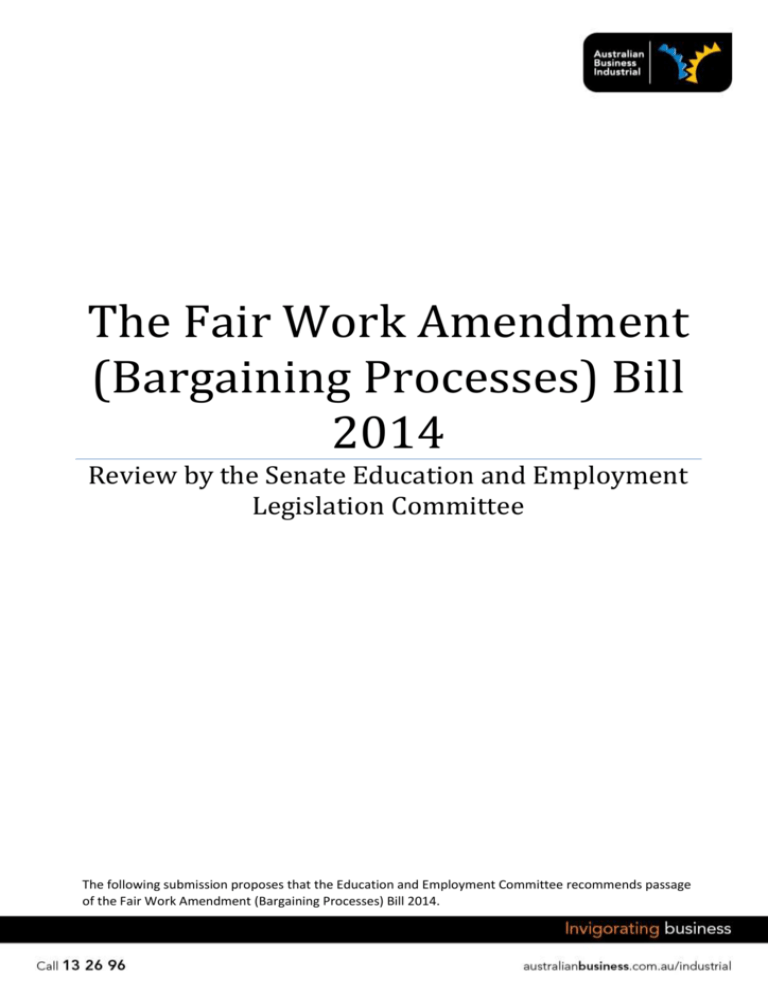
The Fair Work Amendment (Bargaining Processes) Bill 2014 Review by the Senate Education and Employment Legislation Committee The following submission proposes that the Education and Employment Committee recommends passage of the Fair Work Amendment (Bargaining Processes) Bill 2014. Introduction The Government tabled the Fair Work Amendment (Bargaining Processes) Bill 2014 (the bill) on 27 November 2014 and the bill was referred to the Senate Education and Employment Legislation Committee (the Committee) on 4 December for it to inquire into. These are the submissions of Australian Business Industrial (ABI) and the New South Wales Business Chamber Ltd (NSWBC). ABI and the NSWBC thank the Committee for the opportunity to comment and they urge the Committee to favourably consider recommending that the bill be passed. ABI is an organisation registered under the Fair Work (Registered Organisations) Act 2009 and has some 3,900 members. NSWBC is a recognised State registered association pursuant to Schedule 2 of the Fair Work (Registered Organisations) Act 2009 and has some 17,000 members. NSWBC is registered under the (NSW) Industrial Relations Act 1996. ABI comprises those NSWBC members who specifically seek membership of a federal organisation. Contact: Dick Grozier Director of Industrial Relations, Australian Business Industrial and NSW Business Chamber Ltd. Dick.grozier@nswbc.com.au +612 9458 7574 2 Submissions The bill The bill proposes amendments to the Fair Work Act 2009 (the Act). Schedule 1 of the bill contains the substantive proposed amendments and schedule 2 provides for transitional arrangements. Schedule 1 Schedule 1 of the bill proposes to amend four clauses of the Act to address two distinct but related issues in the Act’s bargaining regime. These are the Act’s relative lack of support for the consideration of productivity improvements during bargaining for an enterprise agreement (item 1, schedule 1) and the removal of the Act’s current unintended capacity for there to be lawful industrial action undertaken in the absence of reasonable bargaining (items 2 – 4, schedule 1). Item 1 proposes to insert a requirement into s 187 of the Act that would require the Commission to be satisfied that the parties negotiating the enterprise agreement had discussed productivity improvements in the workplace to be covered by the agreement during their bargaining. S 187 identifies a number of the requirements to be met for the Commission to approve an enterprise agreement. An enterprise agreement does not come into effect unless it is approved. Item 2 is consequential on item 4 below. It relocates but does not itself alter current requirements. Item 3 proposes to amend s 443 of the Act by inserting a new subsection which would require the Commission to consider all relevant circumstances when determining whether an applicant seeking authorisation to ballot employees about taking protected industrial action is genuinely trying to reach an agreement with the employer and identifies a number of factors which should be included in that consideration. S 443 currently requires the Commission to be satisfied that the applicant is genuinely trying as a condition of authorisation, but does not identify what needs to be considered. Item 4 proposes to replace the current s 443(2) which specifies when the Commission must not authorise a ballot with the requirement that the Commission must not authorise the ballot if the claims to be supported by the proposed industrial action are manifestly excessive or would seriously adversely affect productivity. Currently s 443(2) provides that the Commission must not authorise a ballot unless the application is properly made and the applicant is not genuinely trying to reach an agreement. This requirement would continue under the amendment proposed by item 2. The proposed schedule 1 amendments do not constitute a remedy to all of the problems with the current bargaining regime and nor do they propose radical solutions to the two matters which they do address. The proposed amendments are wholly consistent with the policy of the Act and current processes under it. Schedule 2 Schedule 2 proposes transitional provisions which are consistent with the previous amendments to the Act of the kind proposed in the bill. 3 Item 1 transitions the commencement of item 1 schedule 1. Item 2 transitions the commencement of items 2 – 4 of schedule 1. Discussing productivity The object of the Act is to provide a balanced framework of cooperative and productive workplace relations that promotes national prosperity and social inclusion for all Australians. It seeks to do this by providing workplace laws which, amongst other things, promote productivity and economic growth and seek to achieve productivity and fairness through an emphasis on enterprise-level collective bargaining. At the level of its objects the Act undoubtedly gives recognition to the importance of improving productivity in workplaces. Workplaces are regulated by a mixture of the Act’s provisions, awards and enterprise agreements. The structure of the Act is to provide a fair safety net mainly through the National Employment Standards and modern awards. When the Commission makes or varies a modern award it has to take account of the impact on productivity but there is no requirement in the Act for modern awards (nor minimum wages) to promote productivity, and nor are they generally written (or set) to so do. Modern awards should not detrimentally intrude on productivity but they have no statutory role, nor any role in the objects of the Act, to promote productivity. The statutory role of productivity improvement falls to enterprise agreements. The Act regulates the process of making and approving enterprise agreements, and also regulates access to protected industrial action in support of bargaining goals. (Employers cannot initiate industrial action against their employees but they can respond to it.) Protected industrial action is immune from penalty and most breaches of civil and common law. However, apart from the various objects which link the purpose enterprise agreements to improving enterprise productivity the Act provides no specific statutory support for agreements to deal with productivity improvement. Unlike modern awards, when the Commission considers whether to approve an enterprise agreement the Act does not require the Commission to consider its impact on productivity, and nor does it. Relevantly, agreement making is governed by the good faith bargaining principles which are directed to promoting orderly and fair bargaining practices. Importantly, whilst an employer can be compelled to bargain, neither an employer nor its employees (or their representatives) can be compelled to concede, agree to something or to enter into an agreement which they do not agree to. A requirement that agreements support productivity improvement could be inconsistent with these principles, but in any case the proposed item 1 amendment does not do this. Outside the Act’s special arbitration power, the Commission cannot require particular content to be included in, or excluded from, an enterprise agreement. The item 1 amendment does not do this. 4 As suggested by the name “enterprise agreement”, the Act’s enterprise agreement provisions focus on the workplace. Employees can support their bargaining position by undertaking protected industrial action but only for an agreement with a particular employer or for a particular workplace. The key condition for access to protected industrial action is that the applicant is genuinely trying to reach an agreement with the particular employer and another condition is that the union is not pattern bargaining across a number of different employers. Requiring negotiating parties to consider improvements to productivity in the workplace under discussion supports the workplace focus1 of the enterprise bargaining regime. Aside from the less than 1% of agreements2 which cover multiple employers, there are two kinds of enterprise agreements. Most enterprise agreements are with a single employer covering one or more of its workplaces, or parts thereof, and they are made to regulate established on-going operations. A subset of enterprise agreements, greenfields agreements, are negotiated with unions before there are employees employed by the relevant employer. Because of this fact greenfields agreements differ in a number of ways. Greenfields bargaining is the subject of another bill, the Fair Work Amendment Bill 2014. The proposed item 1 amendment in this bill currently before the Committee would not apply to the approval of greenfields agreements.3 Before a party to an enterprise agreement can apply to the Commission for its approval the agreement must be voted on by the employees it will cover and must be approved by a majority of those voting. The process of approving an enterprise agreement requires the Commission to consider a range of factors including whether the employees to be covered by the agreement genuinely agree to the agreement, the employees to be covered were fairly chosen, each would be better off overall under the agreement and also to be satisfied that approving the enterprise agreement would not offend the good faith bargaining principles. The proposed item 1 amendment does not displace any of these other considerations. It does go some way to balancing the Commission’s approval considerations, which unlike the Act’s policy under its objects, are singly focussed on employee protection or benefit. Protected industrial action in support of a bargaining position As noted above a condition for entering into protected industrial action under the Act is that the applicant is genuinely trying to reach an agreement with the employer, and that this is to be understood in the context of the workplace focus of the Act’s enterprise bargaining regime. Pattern bargaining obviously offends this objective because the imposition of common conditions across multiple workplaces fails to address the specific workplace and its needs and excludes the likelihood that productivity improvements specifically appropriate to the particular workplace were considered in the sense intended by the good faith bargaining principles. 1 In extremely limited circumstances there can be agreements negotiated with, and covering, multiple employers. Protected industrial action is not generally available for multiple employer agreements. 2 During 2013-2014 there were 6,754 applications to the Commission to approve enterprise agreements of which 60 were applications to approve agreements covering more than one employer. Table K4, Annual Report 2013-2014, Fair Work Commission 3 Of the 6,694 single employer applications in 2013-2014, 749 were to approve a greenfields agreement. Table K4, Annual Report 2013-2014, Fair Work Commission 5 Section 443 of the Act provides that the Commission must make a protected action ballot order if it is satisfied that the applicant is genuinely trying to reach an agreement with the employer and must not make the order otherwise. Beyond that the Act is currently silent. Items 2 – 4 address two consequences of that silence. Industrial action before there is any bargaining The first consequence of the Act’s silence on the question of what constitutes “genuinely trying” is that because “…genuinely trying to reach an agreement with the employer” is not otherwise specified it is enough to show that the applicant would like to have an agreement at the end of the process. An applicant seeking authorisation for an industrial action ballot is not required to have set about actually bargaining and to have bargained in compliance with the good faith bargaining principles although this is the clear intent of the enterprise bargaining framework. Once bargaining has commenced compliance with the good faith bargaining requirements is a test of whether an applicant is “genuinely trying”. Currently “genuinely trying” can be demonstrated by seeking a protected action ballot order before starting any bargaining, despite the fact that the Act provides a mechanism (such as demonstrating that a majority of the affected employees want to bargain) for employees or unions to have the employer compelled to bargain. A Full Bench of the Commission has found to this effect and the Full Court of the Federal Court has upheld the decision. In the Court’s discussion of the Full Bench’s view that perhaps authorisation of ballots for industrial action should be available before the good faith bargaining principles apply it said: With respect, I would depart from the Full Bench at this point. On my reading of the Act, there is a means by which a party seeking to bring an employer to the bargaining table may achieve that result without taking industrial action. That means is provided in Subdiv A of Div 8. As I have indicated, the legislation eschews any definition of “bargaining”, leaving it to FWA itself to specify what might be required in a particular situation. It is true that, under s 230(2), where the employer has not agreed to bargain or initiated bargaining, there must be a majority support determination or a scope order in operation. These requirements, however, may be seen as a conscious choice by the legislature to introduce a degree of organisation into the representation of employees’ interests, before an unwilling employer might be made the subject of a bargaining order. The important point is that, although limited to an extent, the legislature has, both specifically and in some detail, turned its mind to the means by which an unwilling employer might, to use the Full Bench’s metaphor, be persuaded to come to the bargaining table. Although not so stated in terms, it would be at least consistent with these provisions of Subdiv A of Div 8 to perceive a legislative assumption that recourse to industrial action would not be an available means to oblige an employer, or any other party, to commence bargaining. 4 The Court’s point here seems consistent with the then Government’s stated policy with respect to the Act. 4 Para 28, J.J. Richards & Sons Pty Ltd v Fair Work Australia [2012] FCAFC 53, Jessup J with whom Tracy J agreed. 6 Under Labor, protected industrial action will be available during good faith collective bargaining, but only in accordance with Labor’s clear, tough rules.5 The amendment is also consistent with the recommendation of the Committee of Experts report into the operation of the Act. It said We share the views of the Full Court [in its JJ Richards judgment above]. While the law is now settled, we do not think this is the appropriate outcome from a policy perspective. Given the legislature has sought to codify the circumstances in which an employer can be positively required to bargain, we consider it incongruous for industrial action to be available to bring pressure to bear on an employer to bargain outside of those circumstances. … Recommendation 31: The Panel recommends that Division 8 of Part 3-3 be amended to provide that an application for a protected action ballot order may only be made when bargaining for a proposed agreement has commenced, either voluntarily or because a majority support determination has been obtained. […]. 6 The proposed amendment at item 3 defines what is meant by “…genuinely trying to reach an agreement with the employer” to clearly link the requirement with the good faith bargaining principles and in that way excludes the possibility of a ballot for industrial action being authorised prior to any bargaining commencing. The list of matters the Commission is to have regard to under the proposed new s 443(1A) requires there to be compliance consistent with the good faith bargaining principles (and thus for some bargaining to have taken place) and is itself taken from Commission case law.7 The list is indicative and does not significantly constrain the Commission’s discretion since it requires all relevant circumstances to be had regard to, not just those identified. Industrial action to support unrealistic demands The second consequence of the Act’s silence about “genuinely trying” is that the Commission does not have discretion about the nature of the claims which an applicant for authorisation seeks to support by undertaking protected industrial action. There is clearly a tension between the Act’s general policy embodied in the good faith principles that the bargaining parties should focus on the enterprise and the needs of that business and its employees and the right of employees to initiate industrial action since the experience of industrial action and its aftermath are not conducive to mutual problem solving. For this reason industrial action is appropriately to be regarded and treated under the Act as a last resort. However, the true impact of protected industrial action is not confined to its actual incidence, protected industrial action also impacts the bargaining process when it is raised as a credible threat. 5 P 16, Forward with Fairness - Labor’s plan for fairer and more productive Australian workplaces, April 2007 P 177, Towards more productive and equitable workplaces: an evaluation of the Fair Work legislation, August 2012 7 Total Marine Services Pty Ltd v Maritime Union of Australia [2009] FWAFB 368. This case concerned assessing whether an applicant for a protected ballot order (the Maritime Union) was “genuinely trying to reach an agreement” in circumstances where bargaining had commenced. 6 7 Accepting that this statutory tension exists and that therefore it will give rise to inconsistencies, it seems inappropriately inconsistent for a claim which, if granted, would cause manifest significant ongoing economic damage to the enterprise, and which has been maintained by the applicant despite being properly considered and rejected by the employer (as required under the good faith bargaining requirements) can legitimately found protected industrial action. Item 4 seeks to redress this extreme inconsistency, by substituting s 443(2) with a new subsection which would prevent the Commission from authorising an industrial action ballot where the Commission is satisfied the applicant was pursuing claims which were manifestly excessive in the context of the workplace for which the enterprise agreement is sought and the industry it operates within. This provides a limited discretion since the test that the claims are “manifestly excessive” is a high one, and the Commission is no stranger to the fact that parties enter bargaining with a range of objectives that they do not fully expect to meet, and they enter with ambit. An opposing employer would need to make out both the workplace and industry standards case. Authorisation could also not be given where the Commission is satisfied that the claims would have a significant adverse effect on productivity of the workplace in question. Again this is a high test and the significant adverse impact on productivity would need to be made out in opposition to the authorisation of a protected action ballot. Item 4 is consistent with the objectives of the Act which seek to have productivity promoted through enterprise bargaining and its enactment would not negatively impact on employees’ current right to support their position by taking protected industrial action or its credible threat. It is also consistent with the Act’s general policy and the good faith bargaining principles since the maintenance of a manifestly excessive claim, or claims which would inflict significant damage to productivity, in the face of the reasons that they cannot be agreed to is itself inconsistent with them. The real problem with these types of intractable claims where they arise and persist is that they not only poison the bargaining process and its aftermath but they drive other matters off the table. Schedule 2 Section 2 of the bill proposes the enacted provisions of schedules 1 and 2 would commence on proclamation or 6 months after assent, that is there will be lead time for the new provisions before they come into effect. Schedule 2 provides that item 1 (the requirement to discuss workplace productivity improvements) would apply to any enterprise agreement which is made from that commencement date. An enterprise agreement is made at the time that a majority of the employees who cast a vote in the ballot approve it. The effect of this is that the applicant seeking the Commission’s approval of an enterprise agreement which is made on or after the commencement date would have to satisfy the Commission that productivity improvements had been discussed during its negotiation. This obviously reaches back into the negotiation of agreements during the period before the commencement of the requirement. This approach is consistent with previous treatment of similar types of amendment. For example, the amendment to s 205 of the Act, which deals with the nature of 8 consultation provisions which are to be included in enterprise agreements, made by the Fair Work Amendment Act 2013 which commenced on proclamation or 6 months after assent, also applied to enterprise agreements made on or after the commencement date. The s 205 amendment affected the content of a required term of an enterprise agreement, whereas item 1 would affect discussions which may or may not give rise to one or more terms. Item 2 would apply to items 2 – 4 of Schedule 1 (industrial action) with the effect that the new requirements for authorising a ballot for protected industrial action would apply to applications made on or after the commencement date. Although arguably open to gaming, this is normal. 9

